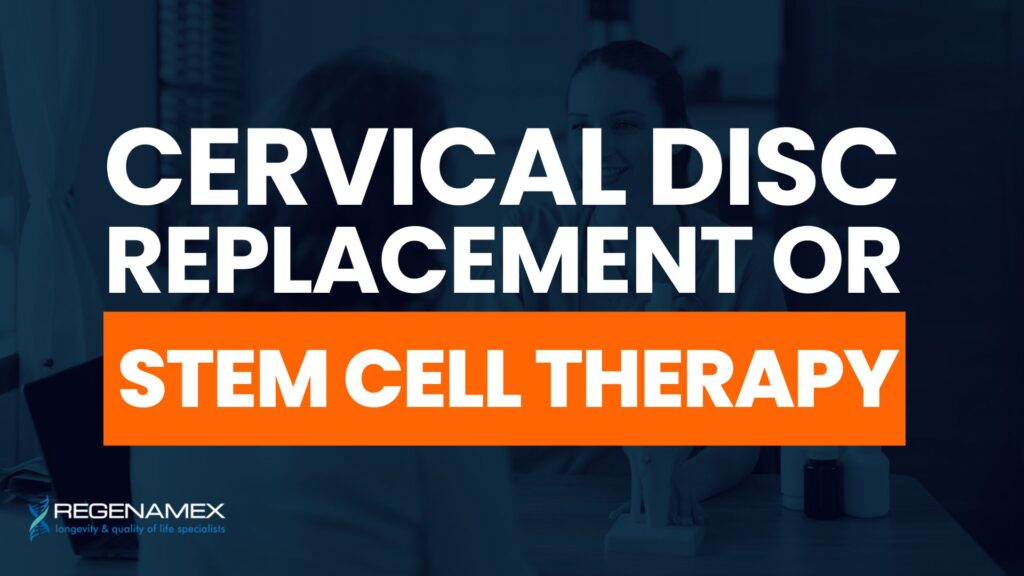
What Is Cervical Disc Replacement or Stem Cell Therapy and How Does It Work?
Cervical disc replacement or stem cell therapy are two distinct treatment paths for addressing damage in the cervical spine the part of the spine located in the neck.
Cervical disc replacement involves removing a worn or herniated disc and surgically replacing it with a synthetic implant designed to restore motion and maintain alignment. It’s typically recommended for patients with severe disc degeneration or nerve compression that doesn’t respond to conservative treatment.
Stem cell therapy, on the other hand, is a non-surgical approach that uses mesenchymal stem cells (MSCs) especially those derived from Wharton’s jelly and placental tissue to regenerate damaged disc tissue, reduce inflammation, and improve spine function. MSCs are injected directly into the affected area, where they begin repairing tissue by modulating the immune response, stimulating healing, and even differentiating into disc-like cells.
At Regenamex, the focus is on Wharton’s jelly MSCs because they have the highest regenerative and anti-inflammatory properties, making them ideal for disc repair without surgery. By offering powerful healing with minimal downtime, this therapy is gaining popularity as an effective alternative to surgical intervention.
Who Benefits from Cervical Disc Replacement or Stem Cell Therapy?

Deciding between cervical disc replacement or stem cell therapy often comes down to understanding your current health condition, lifestyle goals, and how aggressively your symptoms are progressing. Cervical disc replacement is typically reserved for patients with severe disc degeneration who have not found relief through physical therapy, medication, or other conservative methods. These individuals are often looking for a fast, structural fix through surgery and generally have no complicating factors like osteoporosis or spinal deformities that could increase surgical risk. In contrast, stem cell therapy—especially using Wharton’s jelly mesenchymal stem cells—is ideal for individuals seeking a less invasive, more natural route to healing. Patients experiencing moderate neck pain, cervical spondylosis, or herniated discs may benefit significantly from regenerative cell therapy, particularly when the goal is to avoid spinal surgery. This approach also appeals to patients who are not good candidates for surgery due to age or underlying medical conditions. For example, those struggling with conditions like rotator cuff tears or celiac disease have also found value in stem cell therapy, showcasing the broad applications of MSC-based treatments across various inflammatory and degenerative disorders.
Results You Can Expect with Cervical Disc Replacement or Stem Cell Therapy
When considering cervical disc replacement or stem cell therapy, understanding the outcomes you can expect from each is essential for making an informed choice. Cervical disc replacement surgery offers relatively quick mechanical relief by replacing a deteriorated disc with an artificial implant. Post-operative improvements in pain and mobility are often noticeable within the first few weeks, though full recovery may span two to three months and usually includes physical therapy. In contrast, stem cell therapy provides a more gradual yet biologically meaningful recovery. At Regenamex, patients who undergo MSC therapy particularly those using Wharton’s jelly cells often begin noticing reductions in pain and stiffness within 4–6 weeks. Over time, as inflammation subsides and the cells work to regenerate disc tissue, patients may experience improved flexibility, spinal alignment, and a significant reduction in the progression of disc degeneration. Many international patients seeking stem cell therapy choose Regenamex’s clinic in Puerto Vallarta for its advanced, non-surgical protocols that deliver long-term benefits without the need for invasive intervention. This biologic healing makes stem cell therapy a compelling alternative, especially for those seeking a solution that enhances overall spine health not just masks the pain.
Why Mesenchymal Stem Cells from Wharton’s Jelly?

Wharton’s jelly-derived mesenchymal stem cells (MSCs) represent one of the most promising advancements in regenerative medicine, offering a powerful combination of regenerative potential, safety, and ethical sourcing. Extracted from the gelatinous tissue of donated umbilical cords after healthy, full-term births, these MSCs are not only ethically sourced but also highly potent in their therapeutic abilities. Unlike older stem cells harvested from bone marrow or fat which can carry age-related cellular decline Wharton’s jelly MSCs are young, vibrant, and loaded with anti-inflammatory and immunomodulatory proteins. At Regenamex, we’ve chosen to use only these cells because they demonstrate superior outcomes in treating not only disc degeneration but a wide array of autoimmune, orthopedic, and neurological disorders. Whether you’re suffering from cervical spine issues or conditions such as autoimmune disease, the versatility and efficacy of these MSCs stand unmatched. Their ability to reduce chronic inflammation, stimulate cellular repair, and restore structural integrity without the risks of surgery is what makes them the preferred choice for patients worldwide. Learn more about our clinical vision and approach by visiting the About Us page.
How the Treatment Is Performed
At Regenamex, we believe in personalized regenerative care meaning every stem cell therapy protocol is uniquely designed around the patient’s condition, age, weight, and health goals. The process begins with an in-depth medical consultation followed by a tailored plan that typically includes the administration of between 1 million to 5 million Wharton’s jelly MSCs per kilogram of body weight. Depending on the case, stem cells may be delivered intravenously for systemic benefit or locally injected into the cervical disc area to target inflammation and tissue damage directly. Most treatment plans involve one to three sessions completed over a span of several days. International patients visiting from cities like Toronto can expect a 3 to 5-day stay, during which all therapies, pre-treatment assessments, and post-care evaluations are conducted in a comfortable, state-of-the-art clinical environment. Post-treatment, patients often receive nutritional guidance and optional telehealth follow-ups to monitor their recovery and ongoing progress. This streamlined, minimally invasive treatment protocol offers a safe, efficient, and high-impact alternative to cervical disc surgery particularly appealing to those seeking long-term regeneration without going under the knife.
Why Patients Choose Regenamex for Cervical Disc Replacement or Stem Cell Therapy

Patients from all over the world choose Regenamex not only because we provide cutting-edge stem cell therapies but also because of our commitment to ethical standards, patient comfort, and clinical transparency. Located in Mexico and fully licensed, Regenamex specializes in regenerative protocols that exclusively use mesenchymal stem cells derived from Wharton’s jelly and placental tissue. We never use stem cells from adipose or bone marrow due to their lower regenerative potential and higher risk of contamination. Our approach attracts patients who are looking for customized, science-backed care without the inflated pricing of U.S. clinics. Treatments range from just $2,500 to $12,000 depending on the condition, making world-class regenerative therapy far more accessible. With our English-speaking medical staff, international travel assistance, and comprehensive care packages, Regenamex has become a trusted name in cellular medicine. Whether you’re dealing with spinal degeneration, sports injuries, or autoimmune inflammation, Regenamex offers a reliable path toward recovery through ethical science and compassionate care. You can explore our international partnerships and collaborations on Our Partners page.
Frequently Asked Questions About Cervical Disc Replacement or Stem Cell Therapy
Cervical disc replacement or stem cell therapy are two very different approaches used to treat damage in the cervical spine, specifically between the vertebrae of the neck. Cervical disc replacement is a surgical method where a deteriorated or herniated disc is physically removed and replaced with a synthetic implant to maintain stability and motion. Meanwhile, stem cell therapy is a regenerative approach that uses mesenchymal stem cells—particularly from Wharton’s jelly or placental tissue—to help the body heal itself by reducing inflammation, restoring disc hydration, and promoting tissue repair. While both aim to alleviate pain and restore mobility, stem cell therapy seeks to regenerate the damaged disc naturally without the invasiveness of surgery or artificial implants.
Safety is one of the top considerations when evaluating cervical disc replacement or stem cell therapy. Cervical disc replacement, being a surgical procedure, carries the usual risks associated with anesthesia, infection, and recovery time. It also involves the insertion of a foreign object, which can come with its own set of complications over time. Stem cell therapy, particularly with Regenamex’s strict use of Wharton’s jelly-derived MSCs, avoids those risks by providing a minimally invasive, biologically based treatment. Our stem cells are carefully sourced, tested, and processed under the highest standards, making this therapy not only safe but also ideal for patients seeking a natural and low-risk alternative to surgery.
The recovery timeline varies significantly between these two options. With cervical disc replacement surgery, patients may start to feel relief within a few weeks, but full recovery often takes two to three months, including physical therapy. Stem cell therapy follows a more gradual healing process. Patients typically begin to notice improvements such as reduced pain, increased range of motion, and better overall neck function within 4 to 6 weeks. These improvements continue to evolve over the next 6 to 12 months as the stem cells integrate into the tissue, promote regeneration, and help slow or reverse the degenerative process. The timeline may vary depending on the severity of the damage and individual health factors.
One of the major advantages of pursuing cervical disc replacement or stem cell therapy in Mexico is the cost savings without compromising care. Surgical cervical disc replacement in the U.S. can easily exceed $30,000 to $50,000. At Regenamex, stem cell therapy costs range between $2,500 to $12,000 USD, depending on the condition being treated, the number of sessions needed, and the dosage of stem cells. Our all-inclusive treatment packages offer an affordable path to world-class regenerative medicine, particularly for international patients seeking relief from spinal pain. To see a complete overview of pricing, visit our Stem Cell Pricing page.
Regenamex stands out as a premier destination for regenerative medicine, offering an ethical and highly personalized approach to care. What makes us unique in the field of cervical disc replacement or stem cell therapy is our commitment to exclusively using mesenchymal stem cells derived from Wharton’s jelly and placental tissue. We never use bone marrow or fat-derived cells, which have been shown to have lower regenerative potential. Our protocols are medically supervised, our team is trained in international standards of care, and our clinic is fully licensed in Mexico. With personalized treatment plans, affordable pricing, and a high level of transparency, patients from around the world choose Regenamex for the highest standard in non-surgical spine care. Learn more about our mission and team on the About Us page.
Regenerative medicine, including stem cell therapy, is fully legal and regulated in Mexico when administered by licensed medical professionals in certified facilities. Regenamex operates within Mexico’s regulatory guidelines, with all procedures carried out by qualified physicians trained in stem cell protocols. Our therapies meet strict safety standards, and our stem cell sourcing complies with both ethical and medical best practices. Patients often choose to receive cervical disc replacement or stem cell therapy at Regenamex because it offers not only a legal alternative to surgery but also a safer, less invasive approach that adheres to global clinical standards.

